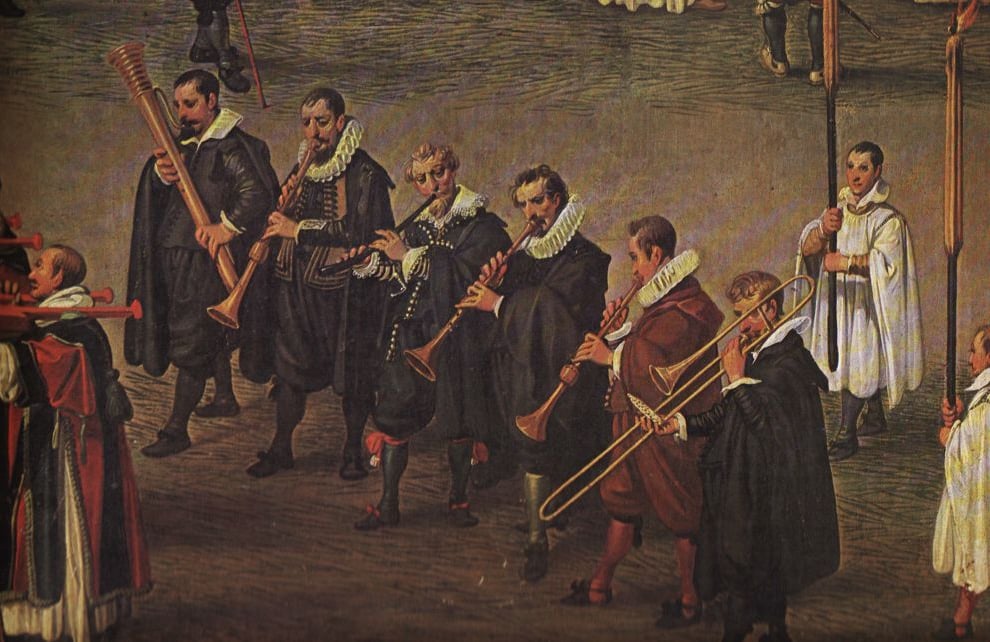The Renaissance was an age of rediscovery - not just in art and science, but also in music. While vocal music still reigned in cathedrals and courts, instrumental music stepped out of the shadows and claimed a spotlight of its own.
No longer limited to mere accompaniment, instrumental compositions began developing distinct forms, and musicians explored the personalities of different instrument families. This chapter dives into how instruments found their voice and rhythm during this fascinating period.
Part 4 - Instrumental Music in the Renaissance Era


Ricercar - The Thinking Man’s Music
The word ricercar means "to seek" - and that’s exactly what this music does. Written mostly for keyboard or lute, ricercars feature complex layers of imitative counterpoint like voices chasing each other (i.e melodies echoing each other), in a musical maze. Think of it as a brainy predecessor to the Baroque fugue.
Instrumental Music Forms
Canzona - The French Song in Italian Clothes
Inspired by French vocal chansons, the canzona became a lively instrumental form with clearly marked sections and contrasting rhythms. It danced with energy and often switched between moods like a musical patchwork quilt. Crisp rhythms, bright tone, and sharp changes between sections.
Toccata - Show-Off Music
The toccata (from toccare, “to touch”) was a flashy keyboard piece, full of quick fingerwork and musical flourishes. It often served as a prelude or opener, showing off the performer’s skill with scales, chords, and free-flowing passages. Quick flourishes, unexpected turns, and dramatic pauses - like musical fireworks!
Pavan & Galliard - Dancing in Pairs
This duo was the ballroom staple of the day.
The Pavan: A slow, elegant dance in duple meter, where dancers moved with dignity.
The Galliard: A lively, leaping dance in triple meter, full of jumps and spins.
They were often paired together, creating a musical balance of calm and excitement. One slow and steady dance followed by a bouncy, triple-time romp.
Fantasia - The Musical Daydream
Unstructured and imaginative, the fantasia gave composers and performers room to roam. It could start with one idea and morph into something completely different- a bit like an early version of a jam session or a musical dream. No clear form; mood changes; playful or mysterious wandering.
Song: Ricercar XXXI
Composer: Francesco da Milano
Song: Canzon per sonar (Canzona to be played on an instrument)
Composer: Giovanni Gabrieli
Song: Toccata
Composer: Johann Staden

Song: Fantasia for Two Instruments
Composer: Orlando Gibbons
Viol (Viola Da Gamba): Bowed, held between the legs, and softer than a violin. Rich and mellow.
Popular Musical Instruments
Lute: Pear-shaped body, plucked; ancestor of the guitar. The Renaissance superstar!
🎻 String Family - The Heartstrings of the Renaissance



Harp: Triangular frame, plucked; common in courtly music.

Vilhuela: A Spanish cousin of the lute and early guitar.
Recorder: End-blown flute; simple and sweet tone. Came in varied sizes.
Shaum: Loud double reed; predecessor of oboe.
🎷 Woodwind Family - Sweet and Strange



Bagpipes: Air supplied through a bag and blown through reeds; street music!


Gemshorn: A flute-like ocarina made of animal horn - rare but notable.
Dulcian: The forerunner of the bassoon; added low-end support in wind bands.

Crumhorn: Buzzing, capped-reed instrument with a J-shaped curve. Quirky in both look and sound!
Sackbut: Early trombone with a sliding tube and a gentle, vocal-like sound.
Cornet (Cornetto): Not to be confused with the ice-cream! A wood/brass hybrid instrument with a clear, trumpet-like tone.
🎺 Brass Family - Bold, Bright, and Regal



Natural Trumpet: Long, valveless trumpet with a noble sound - though limited to the notes of the harmonic series.

Serpent: A bass instrument (early version of the tuba); more prominent in late Renaissance or early Baroque.
Tambourine: Frame drum with jingles; used in dance music.
🥁 Percussion Family - Keep the Beat!


Nakers: Small kettle drums, played in pairs. Similar to India's Nagara Drums.

Chimes & Bells: Rung in religious or ceremonial settings.

Slit drum/log drum: A European cousin to the African log drum - they’re similar in design, but they grew out of different cultural needs and musical traditions.
Woodblock: A small, hollow wooden percussion instrument struck with a stick. Was used in renaissance dance music and processions primarily.

Portative Organ: Small pipe organ held on the lap; pumped by one hand, played with the other.
Keyboard Instruments 🎹


Positive Organ: Larger version placed on a table or stand; used in churches.

Harpsichord: Strings plucked by quills; sparkling yet gentle sound but no dynamic control. Smaller range compared to baroque harpsichord.

Clavichord: A quiet, intimate keyboard instrument with a smaller range than its Baroque counterpart. It allows subtle expressive shading, like gentle vibrato, making it ideal for close-knit performances.

Regel: A small reed organ used in domestic or liturgical settings.
A mesmerising performance!

"Flow, My Tears" by John Dowland is one of the most iconic songs of the Renaissance, originally composed as an instrumental piece titled Lachrimae. Later set to lyrics, it became a powerful expression of sorrow and solitude. With its opening line, “Flow, my tears, fall from your springs,” the song draws listeners into a deeply emotional landscape. Dowland’s descending melody mirrors the falling of the tears, making the music and lyrics inseparable in their expression of heartbreak - a timeless reminder that melancholy is a feeling shared across centuries.
Experience this emotional depth anew through the Berliner Blockflöten Orchester, who bring the piece to life with an expressive ensemble of recorders. From the soaring soprano to the resonant bass, their performance reimagines Dowland’s lute song with the pure, breathy timbres of Renaissance woodwinds. The result is a moving and authentic interpretation that bridges historical beauty with present-day emotional resonance.